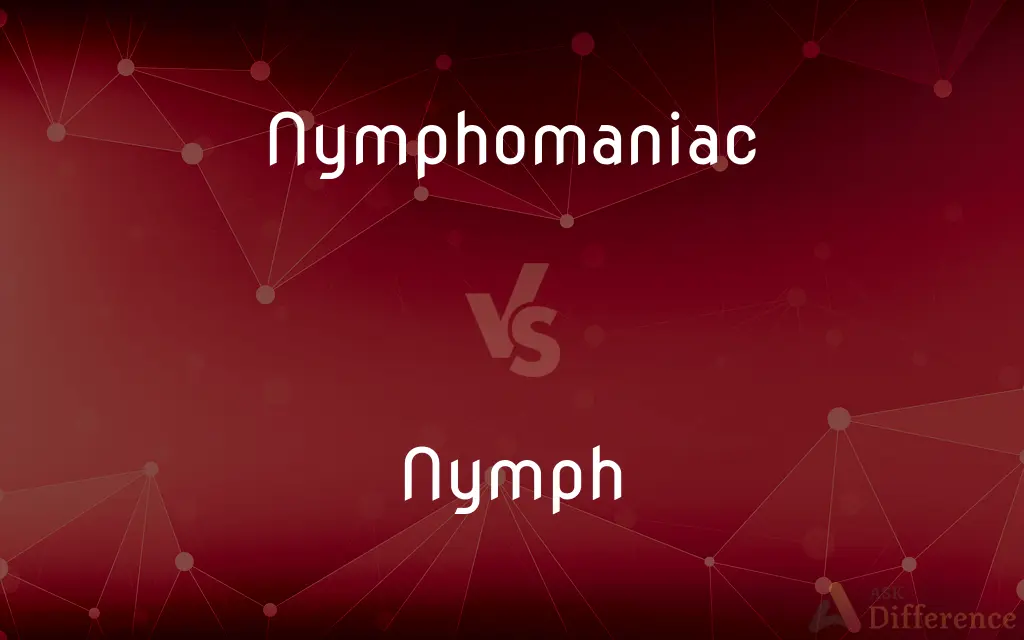Nymphomaniac vs. Nymph — What's the Difference?
Edited by Tayyaba Rehman — By Urooj Arif — Updated on March 9, 2024
Nymphomaniac refers to a person with an excessive or uncontrollable sexual desire, often considered a pejorative term, while nymph, in mythology, is a minor female deity associated with nature, typically depicted as young and beautiful.

Difference Between Nymphomaniac and Nymph
Table of Contents
ADVERTISEMENT
Key Differences
A nymphomaniac is a term historically used to describe someone who experiences an extremely high sex drive or excessive sexual urges, often implying a level of pathology or dysfunction. This term has largely fallen out of favor in professional contexts due to its judgmental and stigmatizing connotations, and it's more accurately referred to in modern psychology as hypersexuality. In contrast, a nymph in mythological contexts represents a divine spirit of nature, embodied as a young and beautiful maiden inhabiting rivers, forests, or other natural locales, not associated with sexual behavior but rather the vitality and beauty of nature itself.
The concept of nymphomania is rooted in medical and psychological discourse, primarily focusing on the individual's behaviors and perceived abnormalities in sexual desire. This perspective has evolved with changing societal attitudes towards sexuality, leading to more nuanced understandings of sexual health and behavior. Conversely, nymphs, as depicted in mythology and literature, are symbolic figures that embody the natural world's enchantment and mystery, often playing roles in stories that emphasize their interactions with gods and humans, reflecting cultural narratives about nature and femininity.
While nymphomania is a concept that has been debated and critiqued within the fields of psychology, medicine, and feminism for its implications and use, the idea of a nymph remains a stable and culturally rich symbol within mythological and artistic expressions. Nymphs are often celebrated in art, literature, and folklore, representing ideals of beauty and the inherent power of nature, whereas the term nymphomaniac has been scrutinized for reinforcing negative stereotypes about female sexuality.
Nymphomaniacs are often portrayed in a negative light in media and literature, with their identities centered around the perceived excessiveness of their sexual desires. This portrayal contrasts with the romanticized and idealized depiction of nymphs in art and mythology, where they are celebrated for their grace, beauty, and natural association, often seen as benevolent figures or as embodying the whimsical and unpredictable aspects of the natural world.
The terminology surrounding nymphomania has shifted towards more clinical and less judgmental language in recent years, reflecting broader changes in how society views and discusses sexual behavior and health. Meanwhile, the concept of nymphs remains a popular and enduring element of mythological and cultural lore, transcending historical periods and continuing to inspire artistic and literary works, highlighting the difference in how these terms function and are perceived in society.
ADVERTISEMENT
Comparison Chart
Definition
Historically referred to a person with excessive sexual desires; now considered pejorative.
A mythological spirit of nature, depicted as a beautiful maiden.
Context
Medical/psychological discourse on sexual behavior.
Mythology and literature, representing aspects of nature.
Cultural Perception
Often stigmatized and associated with pathology; modern terminology shifts towards hypersexuality.
Romanticized and idealized, symbolizing beauty and the natural world.
Representation
Negative media portrayals; focus on sexual behavior.
Celebrated in art and mythology for grace and natural association.
Evolution
Term and understanding have evolved with changing views on sexuality.
Remains a stable symbol of nature's enchantment and beauty.
Compare with Definitions
Nymphomaniac
Changing Perceptions.
Understanding of sexual behaviors, including those previously labeled as nymphomania, has evolved with broader societal changes.
Nymph
Enduring Fascination.
The figure of the nymph continues to captivate in modern times, representing the timeless allure of nature and myth.
Nymphomaniac
Historical Diagnosis.
Nymphomaniac was once a clinical diagnosis for women deemed to have excessive sexual desires.
Nymph
Symbol of Nature.
Nymphs embody the beauty, vitality, and sometimes the perilous aspect of the natural world.
Nymphomaniac
Shift in Language.
Modern discussions prefer terms like hypersexuality to describe uncontrollable sexual behavior without judgment.
Nymph
Artistic Inspiration.
Nymphs have inspired countless works of art, symbolizing idealized beauty and a connection to nature.
Nymphomaniac
Controversial Term.
The term nymphomaniac is now seen as outdated and stigmatizing, reflecting past attitudes towards female sexuality.
Nymph
Cultural Significance.
The concept of nymphs reflects ancient cultures' reverence for and personification of nature.
Nymphomaniac
Media Representation.
Nymphomaniacs are often portrayed problematically in media, focusing on deviant behavior.
Nymph
A nymph (Greek: νύμφη, nýmphē; Ancient: [nýmpʰɛː], Modern: [nímfi]) in ancient Greek folklore is a minor female nature deity. Different from Greek goddesses, nymphs are generally regarded as personifications of nature, are typically tied to a specific place or landform, and are usually depicted as beautiful maidens.
Nymphomaniac
A woman who is affected by nymphomania. No longer in clinical usage.
Nymph
A mythological spirit of nature imagined as a beautiful maiden inhabiting rivers, woods, or other locations
The idyllic world of nymphs and shepherds
A wood nymph
Nymphomaniac
Of or relating to nymphomania. No longer in clinical usage.
Nymph
An immature form of an insect that does not change greatly as it grows, e.g. a dragonfly, mayfly, or locust.
Nymphomaniac
A woman with an excessive libido.
Xenia's such a nymphomaniac that she's not even satisfied with three lovers.
Nymph
A mainly brown butterfly that frequents woods and forest glades.
Nymphomaniac
(of a woman) Having an excessive libido.
Nymph
Greek & Roman Mythology Any of numerous minor deities represented as beautiful maidens inhabiting and sometimes personifying features of nature such as trees, waters, and mountains.
Nymphomaniac
A woman afflicted with nymphomania.
Nymph
A sexually mature and attractive young woman.
Nymphomaniac
A woman with abnormal sexual desires
Nymph
The immature form of an insect, such as a grasshopper, that does not pass through a pupal stage during metamorphosis. Nymphs resemble adults but are smaller and lack fully developed wings.
Nymphomaniac
(used of women) affected with excessive sexual desire
Nymph
The eight-legged immature form of certain arachnids, such as ticks and mites.
Nymph
Any female nature spirit associated with water, forests, grotto, wind, etc.
Nymph
A young girl, especially one who is attractive, beautiful or graceful.
Nymph
(entomology) The larva of certain insects.
Nymph
(entomology) Any of various butterflies of the family Nymphalidae.
Nymph
A goddess of the mountains, forests, meadows, or waters.
Where were ye, nymphs, when the remorseless deepClosed o'er the head of your loved Lycidas?
Nymph
A lovely young girl; a maiden; a damsel.
Nymph, in thy orisonsBe all my sins remembered.
Nymph
The pupa of an insect; a chrysalis.
Nymph
Any one of a subfamily (Najades) of butterflies including the purples, the fritillaries, the peacock butterfly, etc.; - called also naiad.
Nymph
(classical mythology) a minor nature goddess usually depicted as a beautiful maiden;
The ancient Greeks believed that nymphs inhabited forests and bodies of water
Nymph
A larva of an insect with incomplete metamorphosis (as the dragonfly or mayfly)
Nymph
A voluptuously beautiful young woman
Nymph
Mythological Entity.
In mythology, nymphs are depicted as divine caretakers of forests, rivers, and other natural realms.
Common Curiosities
Who are nymphs in mythology?
Nymphs are minor deities or spirits in mythology, associated with nature, often depicted as beautiful, young maidens.
What is the role of nymphs in stories?
Nymphs often appear in myths and stories interacting with gods and humans, embodying the qualities of the natural elements they represent.
How has the perception of nymphomania changed over time?
The perception has shifted from a pathological diagnosis to a more empathetic understanding of hypersexuality, reflecting changes in societal attitudes toward sexuality.
Is nymphomania a medical condition?
Today, the concept of nymphomania is understood within the broader and more nuanced discussions of sexual health and hypersexuality, rather than as a specific condition.
What does nymphomania mean?
Historically, it referred to excessive sexual desires in women, but is now recognized as a problematic and outdated term.
What impact did the term nymphomaniac have on society?
The term contributed to stigmatizing attitudes towards women's sexuality, reinforcing stereotypes and misunderstandings about sexual behavior.
What signifies the difference between nymphomania and high libido?
Nymphomania was viewed as an uncontrollable, pathological condition, whereas high libido refers to a naturally high sex drive without implying dysfunction.
Can nymphs be found in all cultures?
While the concept of nymphs originates from Greek and Roman mythology, similar spirits or deities associated with nature appear in various cultural mythologies.
How are nymphs portrayed in art?
Nymphs are often depicted as embodiments of grace and natural beauty, frequently appearing in idyllic or fantastical natural settings in various art forms.
Why do nymphs remain popular in modern culture?
Nymphs continue to fascinate as symbols of nature's beauty and mystery, appealing to the human fascination with mythology and the natural world.
Share Your Discovery

Previous Comparison
Perspective vs. View
Next Comparison
Bowel vs. IntestineAuthor Spotlight
Written by
Urooj ArifUrooj is a skilled content writer at Ask Difference, known for her exceptional ability to simplify complex topics into engaging and informative content. With a passion for research and a flair for clear, concise writing, she consistently delivers articles that resonate with our diverse audience.
Edited by
Tayyaba RehmanTayyaba Rehman is a distinguished writer, currently serving as a primary contributor to askdifference.com. As a researcher in semantics and etymology, Tayyaba's passion for the complexity of languages and their distinctions has found a perfect home on the platform. Tayyaba delves into the intricacies of language, distinguishing between commonly confused words and phrases, thereby providing clarity for readers worldwide.
















































